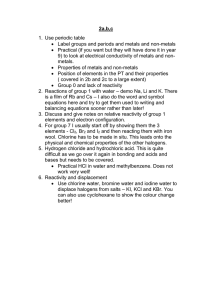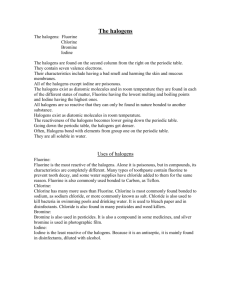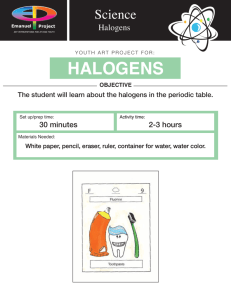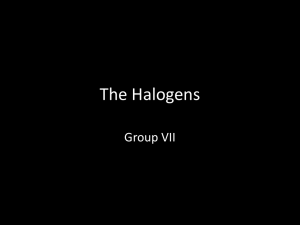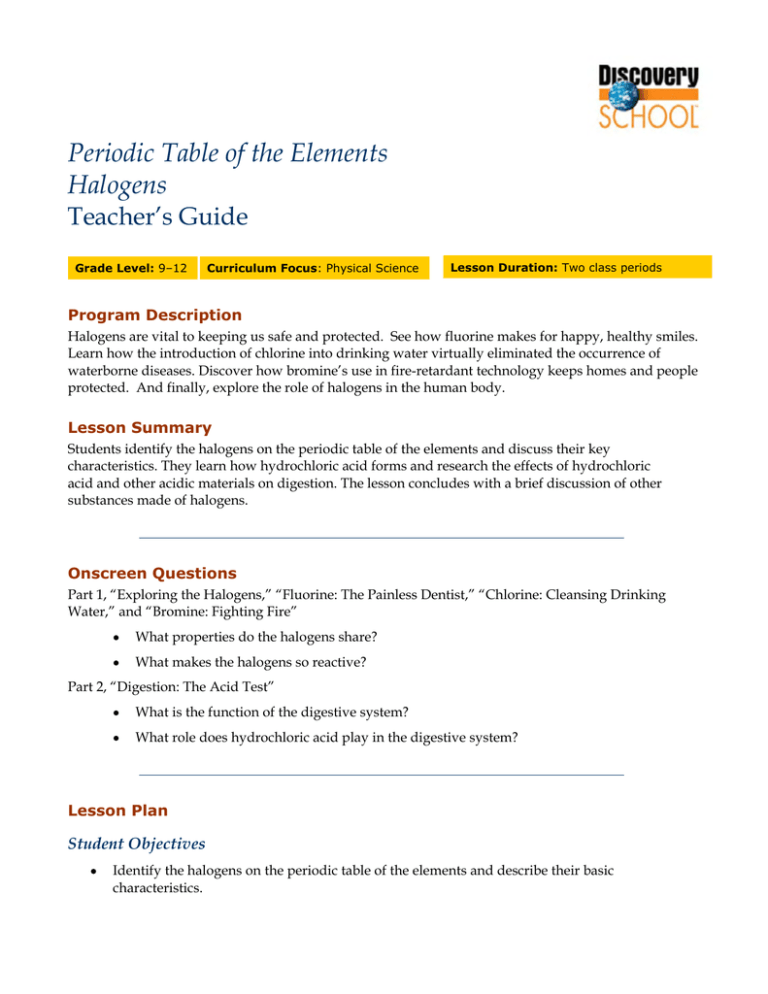
Periodic Table of the Elements
Halogens
Teacher’s Guide
oneone
oee
Grade Level: 9–12
Curriculum Focus: Physical Science
Lesson Duration: Two class periods
Program Description
Halogens are vital to keeping us safe and protected. See how fluorine makes for happy, healthy smiles.
Learn how the introduction of chlorine into drinking water virtually eliminated the occurrence of
waterborne diseases. Discover how bromine’s use in fire-retardant technology keeps homes and people
protected. And finally, explore the role of halogens in the human body.
Lesson Summary
Students identify the halogens on the periodic table of the elements and discuss their key
characteristics. They learn how hydrochloric acid forms and research the effects of hydrochloric
acid and other acidic materials on digestion. The lesson concludes with a brief discussion of other
substances made of halogens.
Onscreen Questions
Part 1, “Exploring the Halogens,” “Fluorine: The Painless Dentist,” “Chlorine: Cleansing Drinking
Water,” and “Bromine: Fighting Fire”
•
What properties do the halogens share?
•
What makes the halogens so reactive?
Part 2, “Digestion: The Acid Test”
•
What is the function of the digestive system?
•
What role does hydrochloric acid play in the digestive system?
Lesson Plan
Student Objectives
•
Identify the halogens on the periodic table of the elements and describe their basic
characteristics.
Periodic Table of the Elements
Halogens
Teacher’s Guide
•
Describe how the halogens react with hydrogen and how hydrochloric acid is formed.
•
Discuss the positive and negative effects that hydrochloric acid and other acidic materials have
on the process of digestion.
Materials
•
Halogens program
•
Computer with Internet access
•
Newsprint and markers
•
Copy of the periodic table of the elements
•
Paper and pencils
Procedures
1. Begin the lesson by asking students to write on a piece of scrap paper the chemical formula
for hydrochloric acid. If students do not know the answer, tell them not to worry about it.
Then ask them to put the piece of paper away until the end of the lesson.
2. Direct students’ attention to the periodic table of the elements in a book or on a class chart.
Point out the halogens. As a class, make a list of the elements in this group, where on the
periodic table they are located, and two characteristics of this group. The chart will include
the following information.
Elements in the Halogen Group
•
Fluorine
•
Chlorine
•
Bromine
•
Iodine
•
Astatine
Group on the Periodic Table
•
Group 7
Characteristics of the Group
•
Toxic and highly reactive
•
Colored nonmetallic elements
•
Color gets darker as you go down the list
•
Low melting and boiling points
Published by Discovery Education. © 2005. All rights reserved.
2
Periodic Table of the Elements
Halogens
Teacher’s Guide
3
3. Now that students have a little background about the halogens, ask them to learn more about
these elements by watching the segment in the program entitled “Exploring the Halogens.”
Have students pay close attention to what happens when hydrogen combines with halogens.
They will find out that substances called hydrogen halides form. When hydrogen halides
dissolve in water, very strong acids form. For example, when hydrogen chloride combines
with water, hydrochloric acid forms.
4. Point out to students that hydrochloric acid plays a role in an important process—digestion.
Ask students to research how hydrochloric acid and other acidic gastric juices affect digestion
and to write a short paper describing their findings. As students work on this project, they
should consider the following questions.
•
How do acids help the digestive process?
•
How can acids negatively affect the digestive process?
•
Why do you think acids have both a positive and negative effect on digestion?
5. To learn more about this topic, have students watch the segment entitled “Digestion: The
Acid Test.” The following Web sites also explain the role of acids in digestion.
http://arbl.cvmbs.colostate.edu/hbooks/pathphys/digestion/liver/bile.html
http://arbl.cvmbs.colostate.edu/hbooks/pathphys/digestion/liver/bacid_hormones.html
http://www.medicinenet.com/gastroesophageal_reflux_disease_gerd/article.htm
http://www.westonaprice.org/knowyourfats/fat_absorption.html
http://digestive.niddk.nih.gov/ddiseases/pubs/yrdd/
6. Give students time in class to work on their reports. Encourage them to include illustrations
to explain key concepts. If students do not finish their reports during class, ask students to
complete the assignment for homework.
7. During the next class period, ask for volunteers to share their reports. Then discuss why acids
have a positive and negative effect on digestion. Make sure that students understand that
hydrochloric acid begins the digestive process, stimulating the pancreas and the liver to
produce key digestive enzymes. Other acids, called gastric juices, are needed to change food
into small molecules that can be absorbed by the body’s cells. But because these acids are so
strong, they can cause harm if they reach parts of the body where they are not supposed to be.
For example, gastroesophageal reflux disease is caused when stomach acids are pushed back
up into the esophagus, the tube that connects the stomach to the mouth. Not only is this
condition uncomfortable, it also can harm the lining of the esophagus.
8. Conclude the lesson by asking students to revisit the notes they recorded at the beginning of
the lesson. Ask students to correct or write the chemical formula for hydrochloric acid,
identify the halogen in this compound, and explain how the acid is formed. (Chemical formula
is HCl; chlorine is the halogen in the compound, and the acid is formed when hydrogen chloride is
mixed with water, resulting in the formation of hydrochloric acid.) Based on what students have
learned about the halogens, can they name common materials that are made up of halogens?
What do these substances have in common? (Possible answers include salt, fluoride used to
Published by Discovery Education. © 2005. All rights reserved.
Periodic Table of the Elements
Halogens
Teacher’s Guide
4
prevent tooth decay, and iodine, an antiseptic used to prevent infection. All of these materials are very
strong and even potentially toxic.)
Assessment
Use the following three-point rubric to evaluate students’ work during this lesson.
•
3 points: Students identified all the halogens on the periodic table of the elements and
accurately described several characteristics of these elements; demonstrated a clear
understanding of the role acids play in digestion and of why acids can have a positive and
negative effect on digestion.
•
2 points: Students identified most of the halogens on the periodic table of the elements and
satisfactorily described at least two characteristics of these elements; demonstrated a
satisfactory understanding of the role acids play in digestion and of why acids can have a
positive and negative effect on digestion.
•
1 point: Students had difficulty identifying the halogens on the periodic table of the
elements and could not describe any characteristics of these elements; demonstrated a weak
understanding of the role acids play in digestion and of why acids can have a positive and
negative effect on digestion.
Vocabulary
digestion
Definition: The process that involves the changing of food into smaller substances that the
body’s cells can use for nourishment
Context: Without stomach acids, the process of digestion could not take place.
gastric juices
Definition: Acidic materials produced by the stomach to break down food into smaller molecules
that can be absorbed by cells throughout the body
Context: Bile is an example of a gastric juice that is produced by the liver and is needed to break
down fat.
gastroesophageal reflux disease (GERD)
Definition: A condition that occurs when the valve that is supposed to close between the
stomach and the esophagus is not working properly and contents from the stomach come back
up into the esophagus, causing an unpleasant burning sensation
Context: In addition to being an uncomfortable condition, if left untreated, gastroesophageal
reflux disease, or GERD, can damage the lining of the esophagus, possibly even leading to
cancer of the esophagus.
Published by Discovery Education. © 2005. All rights reserved.
Periodic Table of the Elements
Halogens
Teacher’s Guide
halogen
Definition: The elements in Group 7 of the Periodic Table of Elements that include fluorine,
chlorine, bromine, iodine, and astatine
Context: The halogens are all toxic, highly reactive, and important elements in many substances
that we use every day.
hydrogen halide
Definition: The gaseous molecule formed when hydrogen reacts with the halogens
Context: When hydrogen combines with chlorine, the hydrogen halide known as hydrogen
chloride forms.
hydrochloric acid
Definition: The substance that forms when hydrogen chloride is dissolved in water
Context: The hydrochloric acid in the stomach protects us from many powerful bacteria.
periodic table of the elements Definition: An organization of Earth’s elements arranged
according to atomic number, the number of protons each element’s nucleus contains
Context: The halogens are in group 7 of the periodic table of the elements and are all colored
nonmetals with low melting and boiling points.
Academic Standards
Mid-continent Research for Education and Learning (McREL)
McREL’s Content Knowledge: A Compendium of Standards and Benchmarks for K–12 Education
addresses 14 content areas. To view the standards and benchmarks, visit http://www.mcrel.org/.
This lesson plan addresses the following national standards:
•
Physical Sciences: Understands the structure and property of matter
•
Language Arts—Viewing: Uses viewing skills and strategies to understand and interpret
visual media
National Academy of Sciences
The National Academy of Sciences provides guidelines for teaching science in grades K–12 to
promote scientific literacy. To view the standards, visit this Web site:
http://books.nap.edu/html/nses/html/overview.html#content.
This lesson plan addresses the following national standards:
•
Physical Science: Chemical reactions
•
Physical Science: Structure and properties of matter
Published by Discovery Education. © 2005. All rights reserved.
5
Periodic Table of the Elements
Halogens
Teacher’s Guide
6
Support Materials
Develop custom worksheets, educational puzzles, online quizzes, and more with the free teaching tools
offered on the Discoveryschool.com Web site. Create and print support materials, or save them to a
Custom Classroom account for future use. To learn more, visit
•
http://school.discovery.com/teachingtools/teachingtools.html
DVD Content
This program is available in an interactive DVD format. The following information and activities are
specific to the DVD version.
How To Use the DVD
The DVD starting screen has the following options:
Play Video—This plays the video from start to finish. There are no programmed stops, except by
using a remote control. With a computer, depending on the particular software player, a pause button
is included with the other video controls.
Video Index—Here the video is divided into sections indicated by video thumbnail icons; brief
descriptions are noted for each one. Watching all parts in sequence is similar to watching the video
from start to finish. To play a particular segment, press Enter on the remote for TV playback; on a
computer, click once to highlight a thumbnail and read the accompanying text description and click
again to start the video.
Curriculum Units—These are specially edited video segments pulled from different sections of the
video (see below). These nonlinear segments align with key ideas in the unit of instruction. They
include onscreen pre- and post-viewing questions, reproduced below in this Teacher’s Guide. Total
running times for these segments are noted. To play a particular segment, press Enter on the TV
remote or click once on the Curriculum Unit title on a computer.
Standards Link—Selecting this option displays a single screen that lists the national academic
standards the video addresses.
Teacher Resources—This screen gives the technical support number and Web site address.
Published by Discovery Education. © 2005. All rights reserved.
Periodic Table of the Elements
Halogens
Teacher’s Guide
7
Video Index
I. Exploring the Halogens (5 min.)
Comprised of fluorine, chlorine, bromine, iodine and astatine, the halogens are highly reactive
nonmetals with relatively low melting and boiling points.
II. Fluorine: The Painless Dentist (5 min.)
A compound of fluorine, fluoride is often added to toothpastes and mouthwashes to help prevent tooth
decay. Learn more about the sources and uses of this common compound.
III. Chlorine: Cleansing Drinking Water (6 min.)
Unsanitary drinking water can spread diseases, as it did in New York City in the 19th century. Explore
how chlorine helps keep drinking water clean and safe.
IV. Bromine: Fighting Fire (6 min.)
Modern science and advances in technology have added another weapon to a firefighter’s arsenal—
brominated fire-retardants. Learn more about the properties and uses of bromine.
V. Digestion: The Acid Test (24 min.)
The world’s most amazing length of plumbing, the digestive tract converts food into fuel. Learn all
about the human digestive system.
Curriculum Units
1. Properties and Uses of the Halogens
Pre-viewing question
Q: What do you know about the nonmetal elements?
A: Answers will vary.
Post-viewing question
Q: How do the halogens appear at room temperature?
A: The halogens are typical nonmetals with relatively low melting and boiling points. The melting and
boiling points of the halogens increase steadily going down the group. Fluorine and chlorine are gases
at room temperature. Bromine is a reddish-brown liquid at room temperature, and iodine and astatine
are solids.
2. Properties and Uses of Fluorine
Pre-viewing question
Q: What do you know about the element fluorine?
A: Answers will vary.
Published by Discovery Education. © 2005. All rights reserved.
Periodic Table of the Elements
Halogens
Teacher’s Guide
8
Post-viewing question
Q: Describe a typical atom of fluorine.
A: Fluorine is an extremely toxic greenish-yellow gas that smells like bleach. It is the most reactive of
all the elements and is never found uncombined in nature. In its most common form, an atom of
fluorine has nine positively charged protons and 10 uncharged neutrons in its nucleus. It has nine
negatively charged electrons in two orbital shells surrounding the nucleus to balance its nine positive
protons. It will always gain an electron when mixed with other elements.
3. Fluoride for Teeth
Pre-viewing question
Q: What common household items contain fluoride?
A: Possible answers include drinking water, toothpastes, mouthwashes, tooth gels, and dietary
supplements.
Post-viewing question
Q: How does fluoride help teeth?
A: According to the American Dental Association, fluoride strengthens tooth enamel and reduces
plaque’s ability to produce acid. It also promotes the repair of tooth enamel that has already been
damaged by acids.
4. Properties and Uses of Chlorine
Pre-viewing question
Q: What are some common uses of chlorine?
A: Possible answers include to clean drinking water and swimming pools and use as an antiseptic.
Post-viewing question
Q: What are some properties and characteristics of chlorine?
A: Chlorine is element number 17 on the periodic table; its atomic symbol is CL. Chlorine is a greenishyellow, dense, sharp-smelling gas at room temperature and is lime green in color in its liquid state.
When frozen, solid chlorine is a lighter shade of green-yellow. It is a highly reactive element that is
extremely water soluble and poisonous.
5. Chlorine: An Ideal Element
Pre-viewing question
Q: What can people do to ensure that drinking water stays clean?
A: Possible answers include keep trash and waste out of the water supply, reduce the use of pesticides
and toxic chemicals, and treat water with chlorine and other sanitizing agents.
Post-viewing question
Q: What makes chlorine an ideal element to sanitize drinking water?
A: Chlorine is an ideal substance to kill microorganisms because it easily dissolves in water and does
not dissipate, killing existing bacteria and preventing new bacterial growth.
Published by Discovery Education. © 2005. All rights reserved.
Periodic Table of the Elements
Halogens
Teacher’s Guide
9
6. Properties and Uses of Bromine
Pre-viewing question
Q: What do you know about the element bromine?
A: Answers will vary.
Post-viewing question
Q: What are some common uses of bromine compounds?
A: Bromine compounds are used in water purification and in creating fumigants and fire-retardant
materials. Silver bromide, a chemical used in photographic film, accounts for the largest use of bromine
today.
7. Bromine: In a Firefighter’s Arsenal
Pre-viewing question
Q: What three things are necessary to create fire?
A: A fire needs heat, fuel, and oxygen.
Post-viewing question
Q: How do brominated fire-retardants work?
A: Brominated fire-retardants, or BFRs, reduce the combustibility of everyday items and hinder the
spread of fire. The bromine in BFRs disrupts the chain reaction that keeps fire burning, effectively
disrupting the flame. Although BFR-protected items may still suffer heat damage, it is the flame that
allows a fire to spread and continue.
8. Basics of Digestion
Pre-viewing question
Q: What do you know about the human digestive system?
A: Answers will vary.
Post-viewing question
Q: What causes excess gas and gas pains?
A: Excess gas may indicate eating too fast and swallowing a lot of air. To avoid excess gas eat slowly
and carefully. Be aware of foods that contain gas, such as carbonated beverages and of incorporating
too many high-fiber foods.
9. Ordinary and Extreme Heartburn
Pre-viewing question
Q: Have you ever experienced heartburn?
A: Answers will vary.
Post-viewing question
Q: What causes heartburn?
A: Heartburn occurs when acid flows up through the stomach into the esophagus. Causes of ordinary
heartburn include overeating and alcohol. Gastroesophageal reflux disease, or GERD, an extreme form
Published by Discovery Education. © 2005. All rights reserved.
Periodic Table of the Elements
Halogens
Teacher’s Guide
10
of heartburn, is caused by a weakness in the lower esophageal sphincter. This weakness allows
stomach contents to flow back into the esophagus, causing pain and indigestion on a regular basis.
10. Food-Borne Bacteria and Ulcers
Pre-viewing question
Q: Have you ever experienced food poisoning?
A: Answers will vary.
Post-viewing question
Q: What causes ulcers?
A: In 1982 Australian doctors discovered that the bacteria Helicobacter pylori is the primary cause of
ulcers. For many years, doctors thought that ulcers were caused by stomach acid and stress. While
these factors can aggravate ulcers, they are not the cause.
11. Living With Crohn’s Disease
Pre-viewing question
Q: How does Crohn’s disease affect the digestive tract?
A: Crohn’s disease can inflame parts of the digestive tract. Doctors do not know its cause or have a
cure.
Post-viewing question
Q: How does the drug infliximab work?
A: Infliximab binds to a key protein that causes inflammation and neutralizes it. It helps alleviate the
pain and discomfort associated with Crohn’s disease. When it is effective, a patient may not experience
symptoms for up to six weeks.
12. Parasites and the Large Intestine
Pre-viewing question
Q: What is the most unusual food you have eaten?
A: Answers will vary.
Post-viewing question
Q: What can you do to protect against digestive illnesses while traveling?
A: A traveler’s best defense includes inoculations specific to a region, knowledge of what medications
to take and what to do when abroad, drinking bottled water, avoiding ice and dairy products that may
have been left at room temperature, and eating cooked foods when they are hot and not at room
temperature.
Published by Discovery Education. © 2005. All rights reserved.

